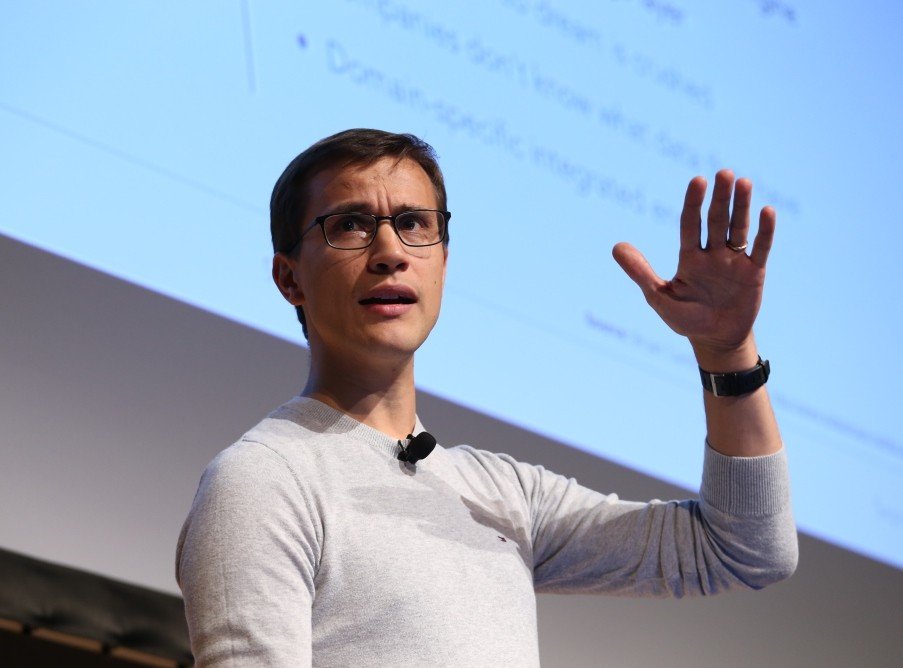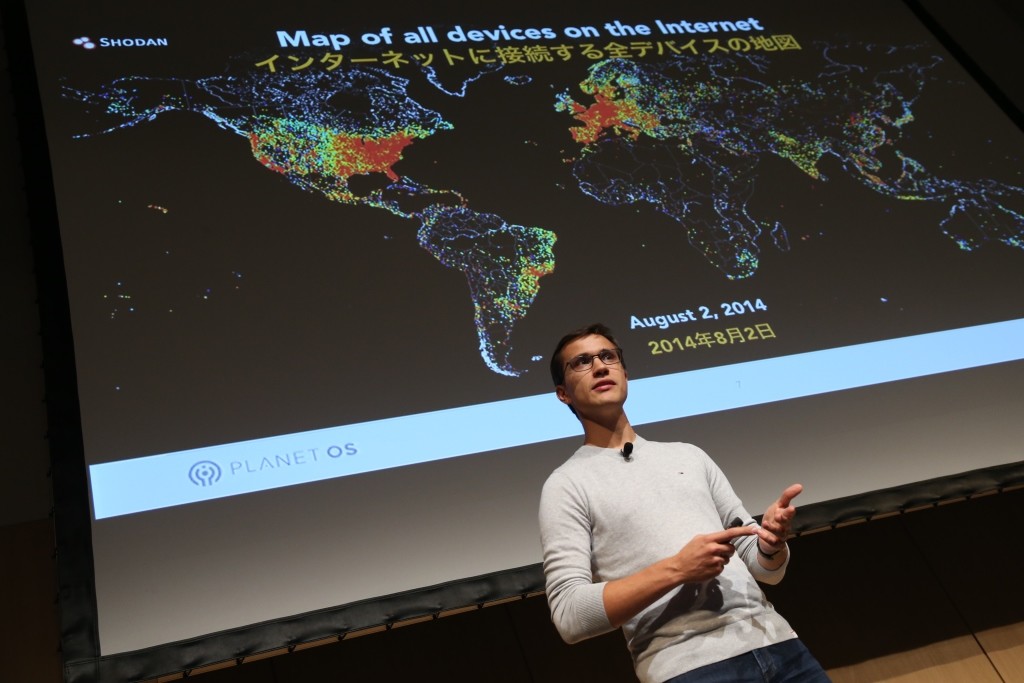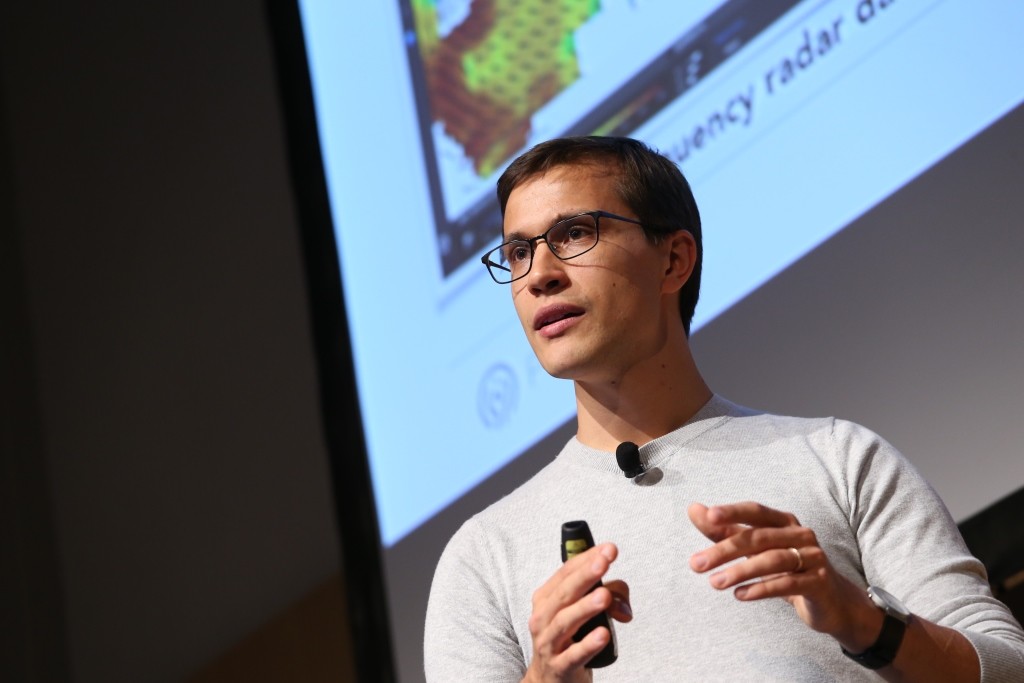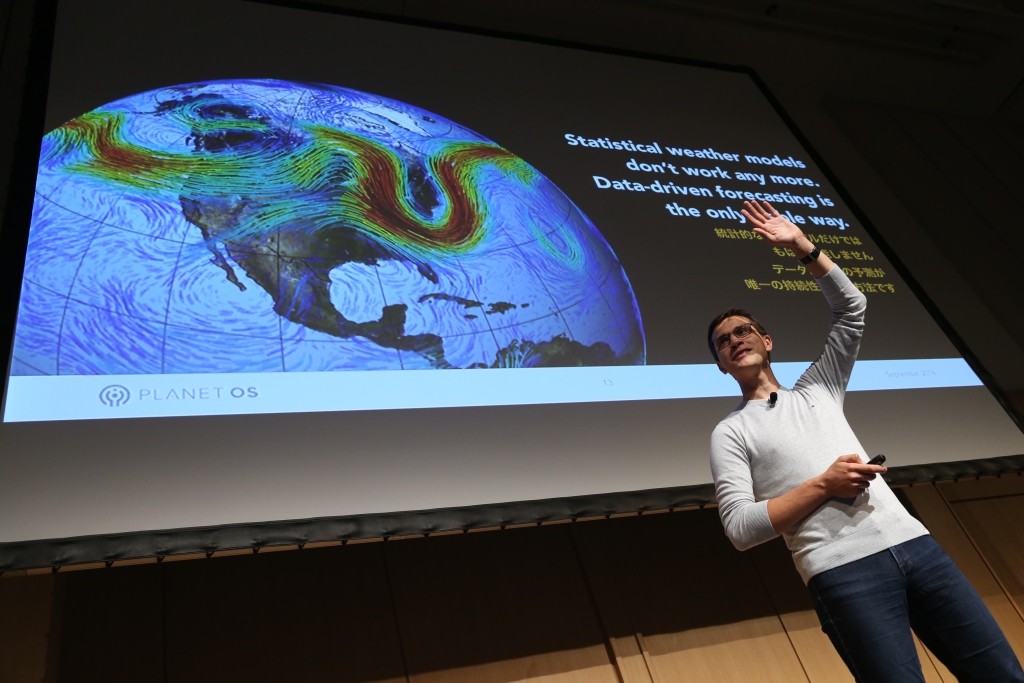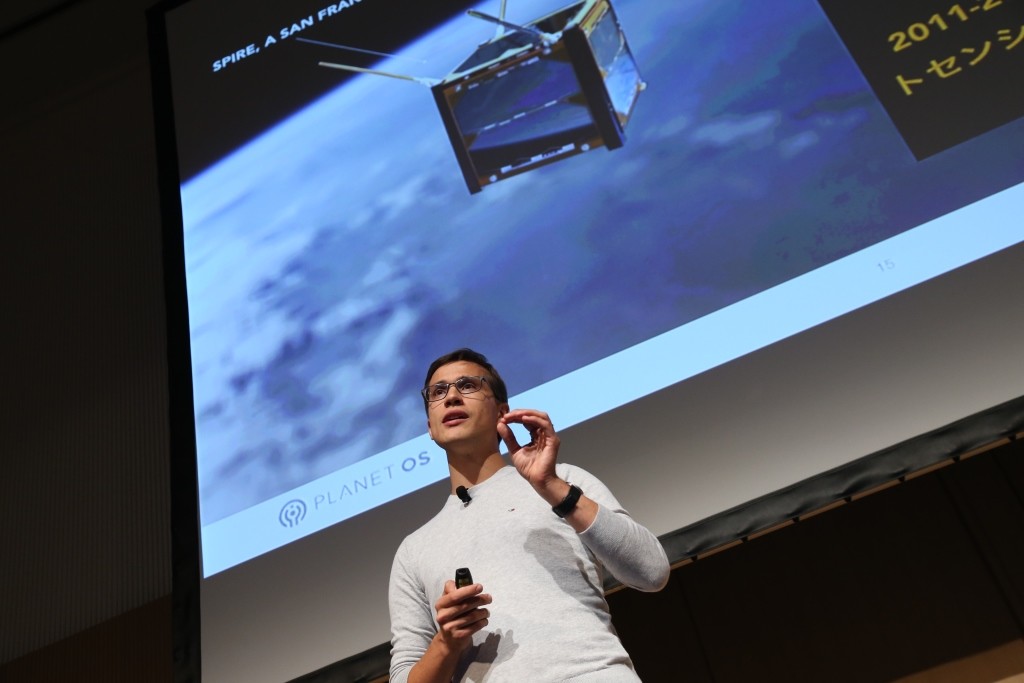He plans to take over the planet. And not just planet Earth but everything that surrounds it too. Not by brutal force but by offering a platform for organising and making sense of planetary sensor data.
“I have a feeling we’ve only just started,” says Rainer Sternfeld (31), CEO and co-founder of Planet OS. In a way, they did just start. While others hit the beaches for the summer, Rainer and his colleagues were busy revamping Marinexplore, a company they founded only two and a half years ago to deal with all sorts of oceanic data, to Planet OS. As the name implies, the ambition of Planet OS goes all the way beyond the 71% of the surface of the Earth covered in water.
“Our system is like Google Translate that speaks the languages of buoys, gliders, satellites and other data mining machines,” Rainer describes the business. “We are the central brain that helps companies and organisations to run and analyse the big data these machines collect on a daily basis, without moving the data itself.”
The problem they are trying solve is best described by the saying, “Swimming in sensors, drowning in data.” Literally every vessel that sails out of any port collects some sort of data, whether it is the just the depth of water and the speed of currents, or more complex data, like the level of contamination or the abundance of fish in the water. In the era of information there is too much data but not enough power or knowledge to analyse it and make it work in our best interests. “Planet OS is like an airport, the people are the data, and the airplanes are the means to bring and send the data, and the gates are the interfaces between them.” Companies and organisations can buy their own “airport”, with their own security, to organise their own data. “And this airport is specialised on all kinds of airplanes, not just one type like many sensor data mostly often are.”
To take a quick history-tour: not much changed in the maritime data for centuries since Magellan’s fleet first circumnavigated the world. If large cargo vessels wanted to cross the ocean, they would have to rely on data collected mostly by visual and manual observations. This did not change much until the first industrial-grade electronic sensors were produced in the 1980s and their mass production really took off only in the 2000s. Since then the price per unit of data has dropped drastically, making all sorts of forecasting equipment accessible for literally anyone.
The keyword here is “speed”. While with the abundance of sensors it became rather easy to collect data, it often takes more than 80% of the time to find, organise and clean the data of all the unnecessary noise. Companies drowning in data realised the more data they have, the less complexity they can afford when analysing it, and the harder it is to find a signal within the noise. This is the direction Planet OS is striving towards.
“There are a lot of old players in this field we are trying to get into,” Rainer claims and quotes Bill Gurley, one of the best known venture capitalists in Silicon Valley: “You can only make money by being right about something that most people think is wrong.”
“The risks are always high and you never know what might work or not,” Rainer keeps his cool, true to his Estonian roots. But having lived in the US for almost three years now he does not shy away from dreaming big: “In addition to Planet OS tools, there are open data. Our goal is to index the majority of publicly available oceanic, land-based and atmospheric data, the real world.”
Currently, Planet OS connects 33 organisations and 37,000+ data collection devices from repositories around the world. They have obviously justified the trust of their biggest investors Intertrust and Philips, and angels like the Nest Labs founder Tony Fadell and Skype founder Jaan Tallinn among others.
Location One: Sunnyvale, California, USA
In the beginning of October it’s still scorching heat outside in the heart of Silicon Valley. I meet Rainer in front of a typical boring-looking glass-and-concrete two-storey office building where he shares a small office with three local colleagues in Sunnyvale, an industrial city known for its history of big companies in aerospace and technology. Moffett Field, the original NASA research base, is only a few miles away.
Rainer looks so much more confident and relaxed as compared to the last time I saw him for an interview in the Bay Area, in March in Crissy Fields near the Golden Gate Bridge. It was rather windy and cold, as the weather tends to be in San Francisco. But at least it’s always very predictable and there is an abundance of information to tell if it’s going to be foggy, rainy or windy.
However, human-made disasters, like something that happened after the BP oil platform exploded and sank in the Gulf of Mexico a few years ago, are harder to predict.
“Each of these oil platforms collects terabytes of data every day and petabytes in a year (which is more than all the pictures on Facebook combined – Editor),” Rainer says, explaining that the problem was not so much in the lack of data but how the oil driller managed the data. The damage could have been much less severe had BP had better integrated data administration. To speak in more understandable terms: the rescue ships were sent out to collect the spilled oil based on the data they received from satellites not considering the fact that there was a considerable time lapse and by the time the ships got there the current had changed and the spilled oil was no longer there. It also took much longer than anticipated to literally put a cap on the spill. As a result an estimated 4.9 million barrels of oil leaked into the Gulf during those 87 days making it the worst oil spill in US history.
Oil producers are the main target group Planet OS is currently offering its services to, since they are the most comprehensive users of sensory data. This is also the reason why the company has two people based in Houston and why Rainer has to travel to Texas more often than you’d expect from a regular Silicon Valley entrepreneur.
To be closer to potential customers and also bigger talent pool is the main reason why Rainer moved his family to California two years ago.
“There are plenty of data science and B2B-software talent here and they have more experience with large volumes of data.”
Location Two: Tokyo, Japan
Just a few weeks earlier Rainer was a guest speaker at the Nikkei Big Data Conference in Tokyo. He obviously connected to the audience who listened in grave silence the whole 30 minutes he talked about the (r)evolution in dig data and sensor networks.
That was his second time in Japan this year and many more similar visits are probably on the way: “This is where our potential customers are.”
Although anyone taking regular flights across oceans and time zones would agree such travelling is no picnic, Rainer does not mind going to Japan every now and then. He confesses that the Japanese culture and traditions resonate well with his personal beliefs.
Before having kids, Rainer and his then newly-wed wife Anu, also a young entrepreneur, took a trip to Japan, backpacking most of the Western and Southern parts of the country. In addition to the more traditional Kyoto, Nara and Hiroshima they covered areas from Nagoya to Ibusuki and climbed Mount Aso, the largest active volcano on Kyushu island. Besides admiring the sheer beauty of the nature, they were also blown away by the Japanese work ethic and discipline visiting a Toyota plant. One day they would want go back with the whole family to see Hokkaido, too.
Speaking of Japan, one could hardly not think about the food. As Rainer considers himself to be a health foodie and taking a systemic approach – like in anything else he does – he could talk for hours about the possible effects of nutrients on human body. Whenever in Tokyo, he likes to explore the tiny eateries in the murkiest parts of the city. While in the Bay Area, he also indulges in Japanese dishes like soba and sushi. Yet he would steer clear of the main delicacy in Japanese cuisine, the Pacific tuna. Not just because of the Fukushima nuclear plant disaster, but he has just seen enough evidence that tuna is the most contaminated fish in the ocean. In fact, he would also not touch Kobe beef as has not been eating any meat since the end of 2010.
Location Three: Tallinn, Estonia
While the Sternfelds “officially” moved to Palo Alto two years ago, they still spend their summers in Estonia and consider Tallinn to be their home. There is no questioning the fact that they will only speak in Estonian at home with their daughters Johanna, five, and Sophia, two, who are also becoming fluent in English.
Planet OS still has their biggest office with seven people in Tallinn as “Estonians are the surviving kind and due to its small population everybody has to be a large-profile specialist”. The climate also supports automation, and people are used to making things more compact and efficient.
This national capital boasts all of the post-Soviet westward-looking Eastern European complexities. Most telling of all, there is the glass-clad modern-looking cross-shaped Statue of Liberty with 200,000 LEDs standing at the backdrop of the medieval Old Town. Rainer was only 24 years old when he co-authored the piece. Yet it took another few years to see it completed.
Not to dwell too deep into the long and complex debate about the symbolism embedded in it and how it finally materialised, Rainer now claims this was a good learning experience in how difficult it is to pull off something big that has never been done before amid all the political turmoil. It is quite obvious that although he’s proud of the fact itself –“I had to do this thing because of all the things that had happened in our family in the past half a century” –, he’s not too happy about the outcome of the whole project. “When I become wealthy enough, I’d like to make a new, better memorial and redeem my debt,” he wows, stressing that design and architecture was, is and will be one of the biggest (secret) passions in his life.
But running big projects at an early age has not been something to hold him back. He was running the Baltic business development branch for the Swiss-Swedish electrical manufacturing giant ABB for five years, starting while he was still a student of the Engineering School at the Tallinn University of Technology. He was in charge of designing the fast-charging infrastructure of electric cars, making Estonia the first country in the world to have a nationwide coverage as of 2013.
While at ABB, he felt the urge “to do something with my own hands” and founded a small prototyping company with his friends. One of the incoming projects was building a data buoy that would measure the concentration of phytoplankton in the Gulf of Finland. “The buoy was long out there and we never heard back from the client, so we found out that they had trouble using the data they had collected as there was too much of it,” he recalls. This is how they realised there was a much bigger data business around getting the sensors physically out there.
Although he’s now in the software industry, his heart is in technology and design for humanity. Growing up in Saue, a small town just on the outskirts of Tallinn, he would tinker in the home office of his father who’s also an engineer, surrounded by books and electronics. While the Soviet Union was falling apart, tensions between Estonians and Russians were running high and gangs of criminals were literally shooting each other on the streets of his tiny home town. Coming from a bilingual family – his mother is Ukrainian – Rainer was an easy target and more often than not he preferred to escape from the troubles of the “real world” outside by staying home and watching a lot of MTV and other utterly western satellite channels as his father, an early adapter to the new uber-capitalist momentum taking ground, had set up one of the first private satellite TV home systems in Estonia in 1989, which followed to his earlier work with satellite heads, speakers and colour TV circuit boards. There was a high demand for these gadgets as everybody was fed up by the monotonous Soviet propaganda and wanted access to the western TV-channels.
Although to this day the experts are still debating the effects of watching too much television, there is no doubt that besides his flawless American English Rainer picked up the sense that knowledge and freedom (to move) are the two most important things in life.
“Our life is so short and we should not be wasting resources (while we are on the track),” he muses. “It is very important to me not to just take up space but be somehow useful to the human kind.”

